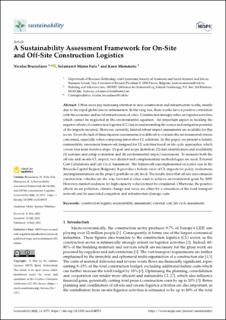| dc.description.abstract | Urban areas pay increasing attention to new construction and infrastructure works, mainly due to the rapid global rise in urbanisation. In the long run, these works have a positive correlation with the economic and social attractiveness of cities. Construction strongly relies on logistics activities, which cannot be neglected in the environmental equation. An important aspect in tackling the negative effects of construction logistics (CL) lies in understanding the source and mitigation potential of the impacts incurred. However, currently, limited robust impact assessments are available for this sector. Given the lack of these rigorous assessments, it is difficult to evaluate the environmental criteria concerned, especially when comparing innovative CL solutions. In this paper, we present a holistic sustainability assessment framework designed for CL activities based on life cycle approaches, which covers four main iterative steps: (1) goal and scope definition, (2) data identification and availability, (3) scenario and setup evaluation and (4) environmental impact assessment. To measure both the off-site and on-site CL impact, two distinct and complementary methodologies are used: External Cost Calculations and Life Cycle Assessment. The framework was implemented on a pilot case in the Brussels-Capital Region (Belgium). It provides a holistic view of CL impacts for policy evaluations and implementations on the project, portfolio or city level. The results show that off-site zero-emission construction vehicles are the way forward if cities want to achieve environmental goals by 2035. However, market readiness for high-capacity vehicles must be considered. Otherwise, the positive effects on air pollution, climate change and noise are offset by a saturation of the road transport network and its associated congestion and infrastructure damage costs | en_US |

